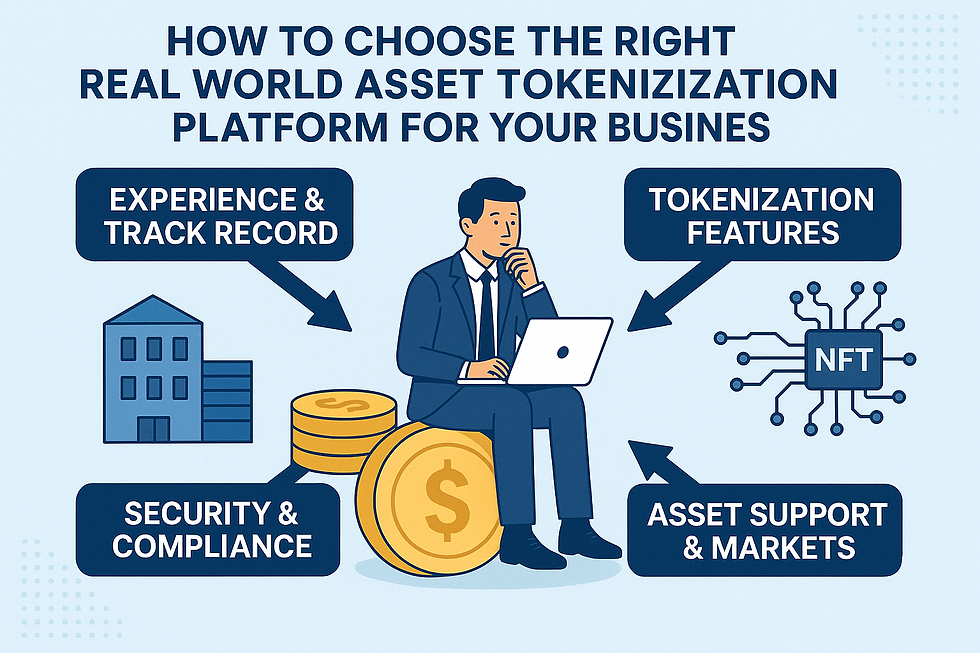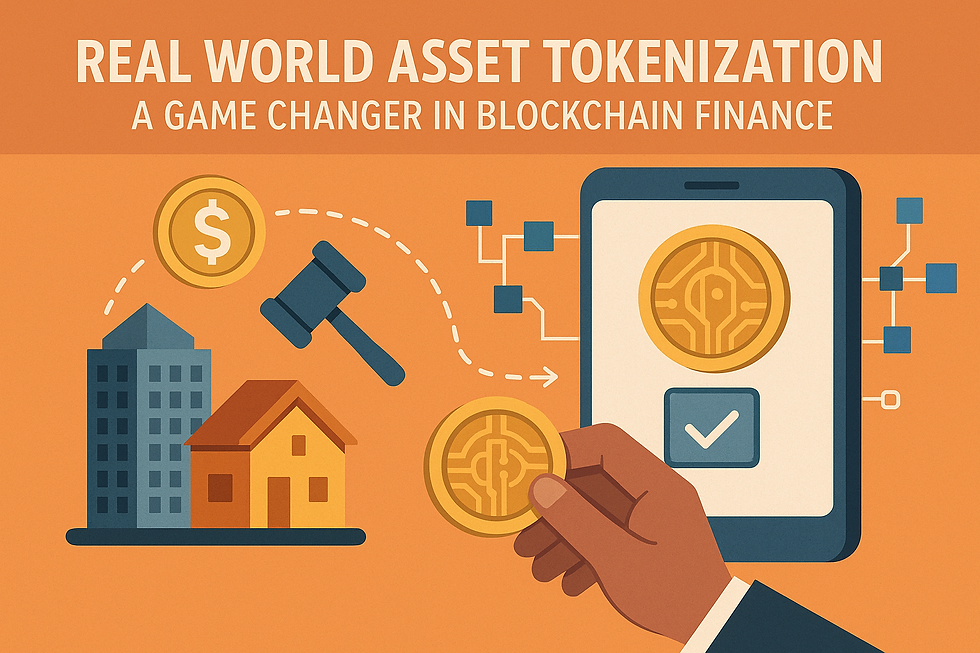Step-by-Step Guide to the Real World Asset Tokenization Process
- steveganger
- Oct 15
- 5 min read

Introduction
The financial landscape is rapidly changing, and one of the most transformative innovations is Real World Asset Tokenization. This powerful process allows physical assets such as real estate, gold, or fine art to be represented digitally on a blockchain. The Real World Asset Tokenization Process helps bridge the gap between traditional finance and blockchain, offering investors and businesses a seamless way to trade, manage, and access value.
But how exactly does this process work? Let’s break it down step by step.
What Is Real World Asset Tokenization?
Real World Asset Tokenization is the process of converting ownership rights of physical or financial assets into digital tokens on a blockchain. Each token represents a fraction of the asset, enabling investors to buy, sell, or trade pieces of ownership efficiently.
Why the Real World Asset Tokenization Process Matters
The Real World Asset Tokenization Process plays a key role in unlocking liquidity for traditionally illiquid assets. It democratizes investment opportunities and makes asset trading faster, more transparent, and more secure than ever before.
Understanding the Core of Tokenization
From Physical to Digital: How Tokenization Bridges the Gap
Tokenization transforms real-world assets into blockchain-based tokens that represent ownership or value. This bridge enables easier transfer, division, and management of assets, reducing barriers to entry for global investors.
The Role of Blockchain and Smart Contracts
Blockchain ensures data integrity and transparency, while smart contracts automate transactions — handling ownership transfers, payments, and compliance with minimal human intervention.
Step-by-Step Guide to the Real World Asset Tokenization Process
Step 1: Identifying the Asset for Tokenization
The process starts by selecting the right asset — it could be real estate, commodities, art, or private equity. The asset must have a verifiable ownership record and clear market value.
Step 2: Legal and Regulatory Assessment
Compliance is critical. Legal experts analyze the jurisdictional laws governing tokenization, securities, and digital ownership to ensure that the process adheres to all regulations.
Step 3: Asset Valuation and Structuring
Before issuing tokens, the asset undergoes a professional valuation to determine its market worth. Based on this, the total number of tokens and their value per unit are structured.
Step 4: Choosing the Right Blockchain Platform
The choice of blockchain impacts the project’s performance and scalability. Popular options include Ethereum, Polygon, and Avalanche. The platform should support smart contracts, token standards (like ERC-20 or ERC-721), and security features.
Step 5: Designing and Creating the Tokens
Here, developers create tokens that represent ownership shares of the underlying asset. These tokens can either be fungible (interchangeable) or non-fungible (unique), depending on the asset type.
Step 6: Smart Contract Development
Smart contracts define the rules of ownership transfer, dividend distribution, voting rights, and compliance requirements. They automate transactions securely without intermediaries.
Step 7: Compliance and KYC/AML Integration
To meet global standards, Know Your Customer (KYC) and Anti-Money Laundering (AML) checks are integrated into the token issuance process, ensuring only verified investors can participate.
Step 8: Token Issuance and Distribution
Once legal, technical, and compliance aspects are complete, the tokens are officially issued and distributed to investors. This is usually done through a secure tokenization platform or private sale.
Step 9: Secondary Market Listing and Trading
Tokens can then be listed on regulated secondary exchanges or decentralized marketplaces, allowing investors to trade them freely. This step enhances liquidity and accessibility.
Step 10: Ongoing Asset Management and Governance
After issuance, continuous monitoring and management are essential. Smart contracts automate reporting, dividend distribution, and compliance updates, ensuring transparency and trust.
Key Players in the Real World Asset Tokenization Process
Asset Owners and Issuers
These are individuals or institutions that hold the physical asset and initiate the tokenization process to raise capital or provide investment access.
Tokenization Service Providers
Companies specializing in blockchain development and tokenization services handle the technical, legal, and compliance aspects of the entire process.
Legal Advisors and Compliance Experts
They ensure that the Real World Asset Tokenization Process follows all regulatory frameworks, preventing issues with securities laws and investor protection.
Blockchain Developers and Custodians
Developers build the tokens and smart contracts, while custodians safeguard the underlying assets and digital tokens securely.
Benefits of Following a Structured Tokenization Process
Increased Liquidity and Transparency
Tokenization transforms illiquid assets into tradable tokens, offering investors liquidity while ensuring every transaction is transparent and traceable.
Cost Efficiency and Global Access
By reducing intermediaries and paperwork, the Real World Asset Tokenization Process minimizes costs and enables investors from around the world to participate seamlessly.
Investor Confidence and Regulatory Compliance
A structured tokenization process backed by blockchain records builds investor confidence, while adherence to legal standards ensures long-term sustainability.
Real-Life Examples of Tokenized Assets
Tokenized Real Estate Projects
Developers can tokenize luxury apartments or commercial buildings, allowing investors to purchase fractions of property ownership and earn rental income digitally.
Commodities and Fine Art Tokenization
Gold reserves, rare paintings, and collectibles are increasingly being tokenized, enabling fractional ownership without physical handling or storage risks.
Private Equity and Infrastructure Assets
Tokenizing shares in private companies or large-scale infrastructure allows investors to access opportunities traditionally limited to institutional players.
Challenges in the Real World Asset Tokenization Process
Regulatory Complexity
Laws vary across countries, and uncertainty around classification of tokens as securities can delay adoption and cross-border operations.
Technical Integration Issues
Integrating smart contracts, secure wallets, and blockchain networks demands technical expertise and infrastructure investment.
Market Adoption and Awareness
Many traditional investors and companies are still unaware of the benefits, requiring education and ecosystem development for widespread use.
Future Outlook: The Evolution of the Tokenization Process
Integration with DeFi and Digital Banking
The next wave of innovation will merge tokenized assets with decentralized finance (DeFi) platforms, enabling lending, staking, and yield generation from real-world value.
Cross-Border Tokenization Ecosystems
As global regulations align, tokenized assets will move seamlessly across jurisdictions, empowering investors with global portfolios built entirely on blockchain.
Conclusion
The Real World Asset Tokenization Process is reshaping how assets are created, owned, and traded. It’s not just a technological trend — it’s the foundation of the next-generation financial ecosystem.
By following a structured process that includes legal compliance, smart contract development, and secure distribution, businesses and investors can unlock new levels of liquidity, efficiency, and trust in the global market.
Tokenization isn’t the future — it’s already here, and those who embrace it today are paving the way for a more inclusive, transparent, and borderless economy.
FAQs
1. What is the Real World Asset Tokenization Process?
It’s the method of converting physical or financial assets into blockchain-based tokens representing ownership or value.
2. Which assets can be tokenized?
Assets like real estate, gold, art, equity, and infrastructure can all be tokenized.
3. Why is blockchain important in tokenization?
Blockchain ensures transparency, security, and immutability, while enabling instant and verifiable transactions.
4. What are the benefits of tokenization for investors?
Investors gain liquidity, fractional ownership, and global access to diversified asset classes.
5. Is Real World Asset Tokenization legal?
Yes, but it depends on regulatory compliance in each jurisdiction. Many regions are now creating clear frameworks for legal tokenization.



Comments